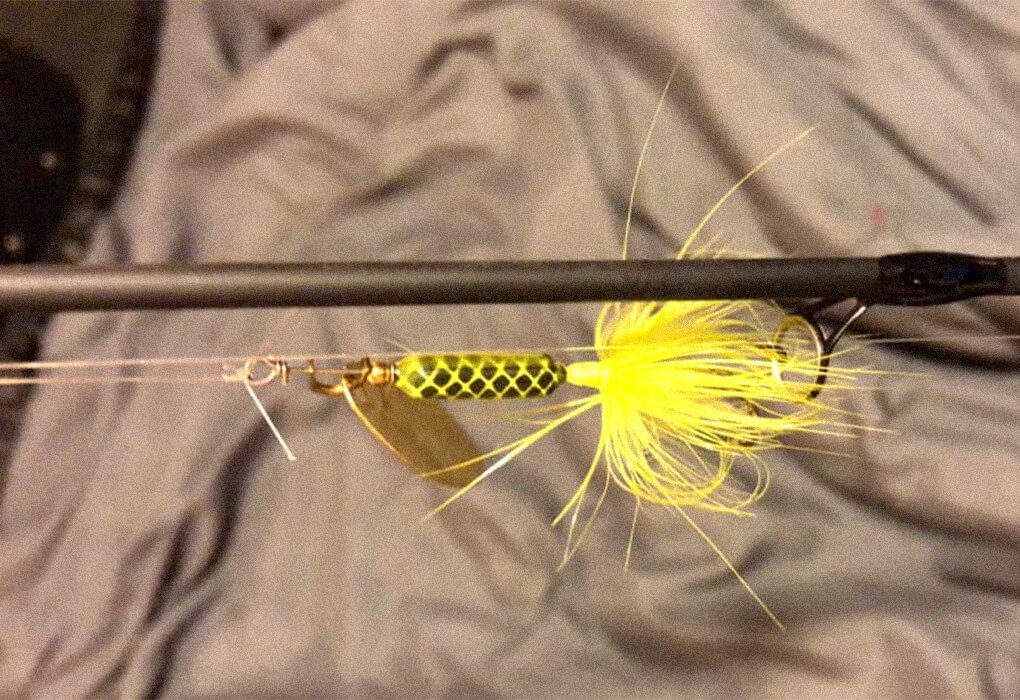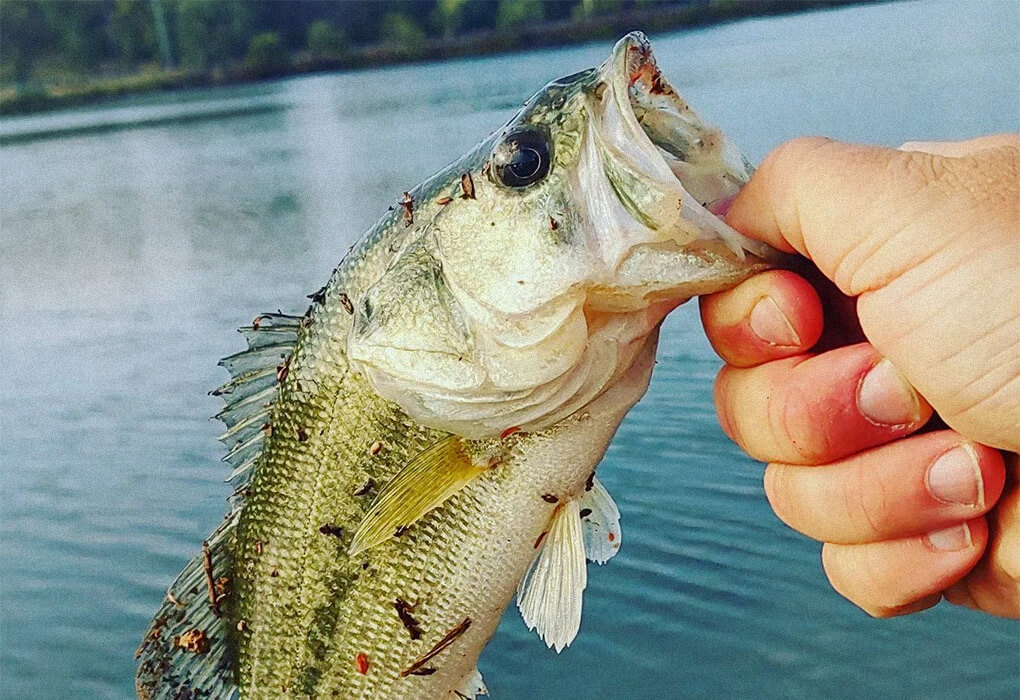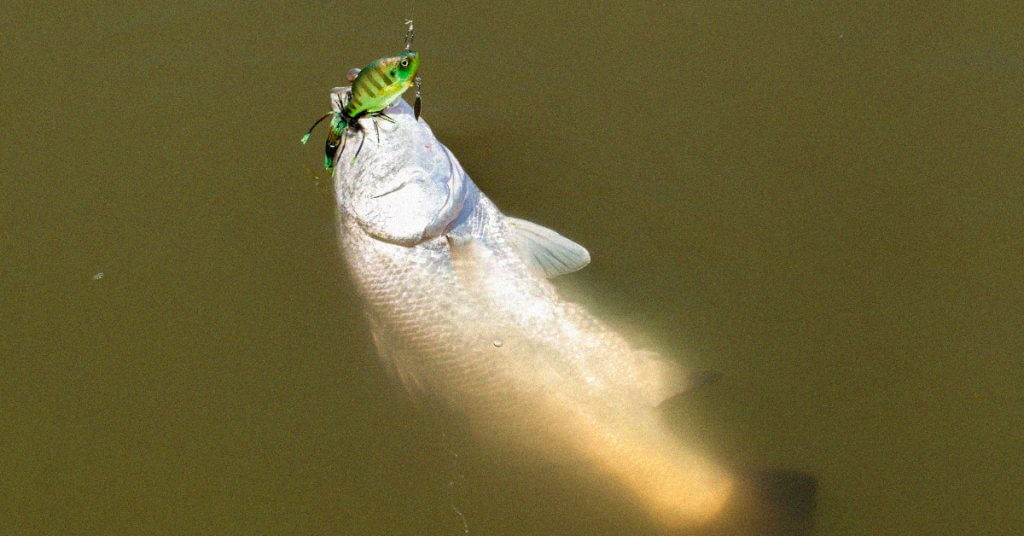With more and more new fishing lures on the market, anglers are finding themselves with tons of options to choose from to help them catch more bass.
But there’s a lure that often gets overlooked that has been proven to catch bass time after time and that is the Rooster Tail!
If you aren’t using Rooster Tails for bass you’re missing out on a hidden gem!
Table of Contents
Are Rooster Tails Good for Bass?

Despite being a lure that is predominantly used for trout fishing, Rooster Tails are great for catching bass. I’ve used these lures since I was a kid and can vouch for their effectiveness after numerous successful fishing trips.
One of my best bass fishing trips came when I was using a Worden’s Original Rooster Tail.
I was fishing a local river and came upon some water flowing out of a small creek. I noticed several largemouth bass crashing on the water’s surface. The bass were chasing minnows about 12 feet away from the shoreline.
I used my trolling motor to sneak into the action and when I was within casting distance I excitedly grabbed my spinning reel rod that had a Yakima Bait Wordens Rooster Tail tied on.
The lure was yellow with green spots on the body and I used it so much that the paint was starting to wear off.
I casted it out and reeled it in fast to keep it near the surface of the water where the bass were feeding.
On the first cast I caught a largemouth bass and remember the action being so fast that I caught a bass on my first four casts.
I caught about 25 bass that morning. Most of them weighed between a pound and two pounds with the heaviest being 3.2 pounds.
The highlight of the day came when I was reeling in a bass and looked down into the water to see another bass swim up to the bass that was on the line.
The bass tried to get the Rooster Tail out of the bass’ mouth and hooked himself. I grabbed the net and managed to net both fish.
When I got the fish into the boat they were hooked on separate hooks.
That’s a great memory that I have from using a Rooster Tail on a bass fishing trip.
Since that trip I have purchased over 20 different types of Rooster Tails made by companies like Goture, Blue Fox, Panther Martin, and have even customized my Rooster Tail spinner by adding larger spinners and using different feather dressings.
In fact, one compartment of my tackle box is reserved for Rooster Tails and similar inline spinners.
How to Rig a Rooster Tail for Bass

Rooster Tails are one of the simplest fishing lures to rig even though they are made up of five different parts.
Wire Shaft
The wire shaft is basically the “axle” that the entire lure is attached to. The top of the wire is the eye where the line is tied to the lure.
Blade or Spinner
On most Rooster Tails the blade comes before the actual body of the lure. The blade is what attracts bass because of its ability to catch the sunlight and flash in the water just like a shiner or some other type of baitfish.
Rooster Tail spinners can be interchanged using an o-ring to connect the blade to the lure. Blades come in all different shapes, sizes, and colors.
Body
The body of a Rooster Tail is long and cylindrical. The wire shaft runs inside the body through a hole in the center.
Dressing
The dressing or skirt is a set of small feathers that come before the treble hook. This is how the Rooster Tail is different from other lures and it’s actually how the lure got its name.
The creator of this lure saw the tail feathers on his rooster and thought the long flowing tail feathers could attract fish if added to a hook.
Treble Hook
The final piece is the treble hook. It is attached at the end of the wire shaft.
Rooster Tails aren’t versatile meaning they can’t be fished on the bottom like a jig, under a cork, or used on the surface.
They work best when used to catch suspended bass. To rig a Rooster Tail, simply tie your line to the eye of the lure, cast out, and retrieve.
How to Fish a Rooster Tail for Bass
Fishing for bass with Rooster Tails is similar to using a spinnerbait.
I find that Rooster Tail fishing works best when using a spinning reel and monofilament fishing line.
Since these lures can be casted farther than normal bass lures, because of the weight and size, I find it best to use a 7-foot fast action rod with a fast rod tip.
Simply flip the bail on your reel and cast the lure out to your desired spot; preferably near a patch of lily pads or structure in the water.
The important thing to remember when using a rooster tail is when the lure hits the water, it needs to be reeled in quickly because it’s a heavy lure and will sink fast.
If you let the lure sink to the bottom the chances that it will get caught on something on the bottom increases.
Remember, Rooster Tails have treble hooks which mean they snag just about anything that the hooks come across.

When fishing Rooster Tails for bass that are feeding on minnows on the surface, simply reel the lure in fast to keep it near the surface.
Another option to keep the lure near the surface is to use a Rooster Tail with a large spinner. The bigger spinner moves more water and allows the bait to flutter near the surface when reeled in.
There is one downside to using a Rooster Tail for catching bass. I find that they are extremely hard to fish in areas with a lot of submerged grass.
The lures can’t be rigged weedless because of the treble hook trailer on the back, so they tend to snag grass and weeds that are in the water.
When choosing a color, I find it best to match the color of what the bass are feeding on in the area you are fishing.
For instance, if the bass are chasing minnows and shad, then the best color would be a silver or gray colored Rooster Tail.
If it’s spring, and the bass are feeding on frogs, it’s best to use a green or yellow Rooster Tail to match the color of the frogs that the bass are feeding on.
Also, when fishing in muddy water, it’s best to choose a bright colored Rooster Tail like chartreuse yellow or green. White lures also work well in muddy water.
When fishing in clean water it’s best to use natural colors like silver or clear.
What Size Rooster Tail for Bass?
Rooster Tails come in various sizes but the size I prefer to use is a ⅛ oz lure because it catches both medium sized bass and smaller bass. Anything smaller will catch bluegill and crappie along with small bass.
If you are looking to catch bass that weigh over 3 pounds then you should go with a larger Rooster Tail like a ½ oz lure. I find that using larger Rooster Tails tend to catch larger bass.
Also using a lure with a large spinning blade helps in catching big bass.
Frequently Asked Questions
Do you use a weight with a rooster tail?
No. Rooster Tails are naturally weighed and do not need extra weight added to the line.
How do you use a Rooster Tail for bass?
When using a Rooster Tail to catch bass it’s best to cast out near some sort of structure or grass. Then reel the lure in at a medium speed.
I recommend trying to keep the lure in the middle of the water column.
What fish are Rooster tails good for?
Rooster Tails have found a home in the trout fishing world and are fantastic for catching freshwater trout, especially in brooks or streams.
But Rooster Tails can also catch bass, bluegill, panfish, crappie, and saltwater fish like striped bass and redfish. The lure is very versatile when it comes to catching different fish.
Final Thoughts
While Rooster Tail lures fall into the category of trout lures, I’ll argue that these baits can rival even the best bass lures on the market.
The variety of sizes, colors, feathers, and spinners make these lures great for targeting largemouth bass and smallmouth bass in any type of water.
The casting distance is also a benefit as Rooster Tails can be launched farther than typical bass lures.
If you’ve never tried using Rooster Tails, I highly recommend you try one on your next fishing trip.





